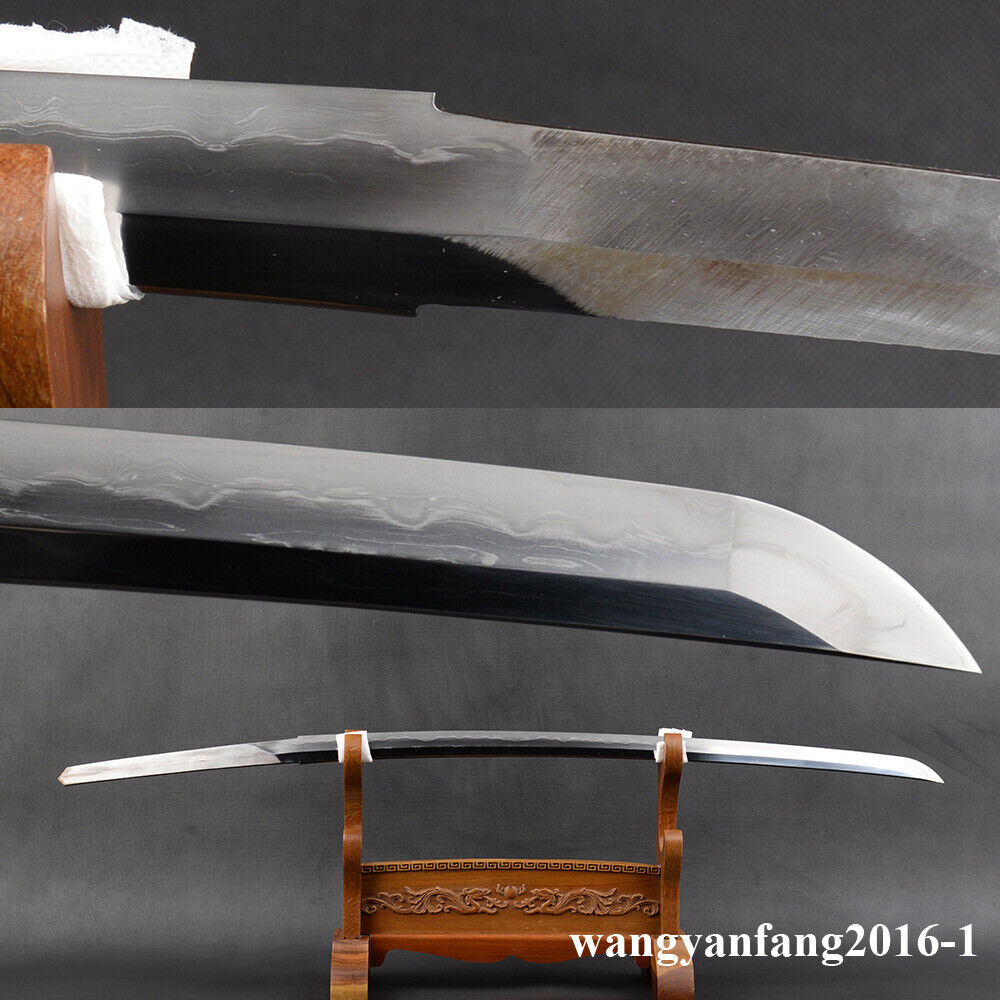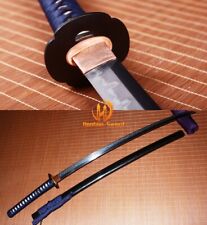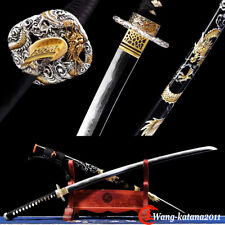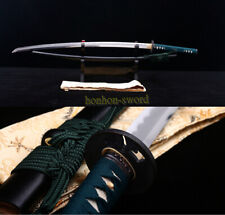When you click on links to various merchants on this site and make a purchase, this can result in this site earning a commission. Affiliate programs and affiliations include, but are not limited to, the eBay Partner Network.
Japanese Samurai Katana Sword Kobuse Bare Blade Clay Tempered Folded Steel
Item Specifictions:Material: Hand folded T10 steel by 15 times (32768 layers).Damascus folded steel,百炼钢Craft: Kobuse,Clay tempered,Folded,fully hand forged with 13 procedures,Quenched and mirror polish,etc .
Hamon: Graceful handmade clay tempered real hamon + natural riffle texture,caused by folding process.Polish Style:Hadori polishingBO-HI: No blood grooveBlade Hardness(HRC): 60
Nakago(Tang): Full tang
Whole length: 97.4cm(38.35")
Blade length: 70.4cm(27.72")
Nakago length: 27cm(10.63")
Width: 3.2cm(1.26")
Thickness: 0.7cm(0.28")
Habaki: high quality BrassPackage Includes: 1 * naked blade + 1 Habaki-Please note: Usually we don't maintain the nakago part. Even some users won't remove the rust on the nakago because it can make the blade more firm. The rust on nakago is not quality problem. Tks for your understanding. There is no hole on the nakago/tang of the blade. If you need that, please contact us before payment.The Modern Style Polishing(Hadori Style Polishing 刃取): It is designed to highlight the aesthetics of the blade. In this style polishing, the hamon appears white against the black, shining steel and the mirror finished shinogi-ji. It is so aesthetic that it makes a blade perfect for display The white pattern that looks like hamon is called "HADORI". It is not a true hamon, but it is designed by polisher along the hamon to exaggerate it. When you look at the blade under a proper light, you can see the true hamon under the hadori.With the modern polishing style, you can see the blades with aesthetically "made-up face". This polishing style was developed by a famous polisher in the early 20th century.Kobuse:
The vast majority of modern katana andwakizashi are the maru type which is the most basic,with the entire sword being composed of a single steel.The kobuse type is made using two steels, which arecalledhagane(edge steel)andshingane (core steel).Steel of different materials is forged and weldedtogether to hammer the basic shape of the sword.This allows the overall blade to have a higher toughness andabsorba lot ofimpact.Reducing the possibility of breaking or bending to some extent.Makes the blade notonly has high hardness, but also has super toughness.
T10 carbon steel:
The best quality of high carbon steel is T10, the carbon content was 1.03%, and the element contains a small amount of chromium, molybdenum, vanadium, after heat treatment can reach HRC 58-60 hardness. Toughness is very good, but it is not resistant to rust. It is applied to traditional european-style hunting knife, large cutting knife and military dao.
SWORD MOUNTINGS FOR CHOOSINGENGRAVING SERVICEHOW TO DISASSEMBLE A JP SWORDSWORD MAKING PROCESSESDELIVERY DETAILS & PAYMENTSWORD MOUNTINGS FOR CHOOSING
If you don't like the color or the style of the mountings, you can choose different ones from the options below. Just tell us your choice before purchase.
TSUBA
The tsuba (鍔, or 鐔) is usually a round (or occasionally squareish) guard at the end of the grip of Japanese swords. They contribute to the balance of the sword and to the protection of the hand. The tsuba was mostly meant to be used to prevent the hand from sliding onto the blade during thrusts as opposed to protecting from an opponent's blade.
TSUBATSUKA-ITO & SAGEO
Tsuka-ito is the wrapping of the tsuka and sageo (下緒 or 下げ緒) is a hanging cord that is passed through the hole in the kurigata (栗形) of a Japanese sword's the ray or shark skin wrapping of the tsuka saya is a wooden scabbard for the blade; traditionally done in lacquered wood.
ENGRAVING SERVICEIt is freefor engraving English words,Chinese characters and Japanese Kanji.You need pay additional $20 for engraving patterns (dragon, lion, etc.) or other logos.HOW TO DISASSEMBLE A JP SWORDSWORD MAKING PROCESSES
Forming
Swords can be shaped by a variety of metalworking techniques.The primary techniques are forging and stock removal.
Forging uses heat to bring the material to a malleable state. The material is then hammered to shape, typically using hammer and anvil together with specialized set and fuller tools depending on the particular technique.
Stock removal shapes the sword from prepared stock that is larger in all dimensions than the finished sword by filing, grinding and cutting.
Quenching
After the blade has been shaped, the sword would be quenched. We quench our swords in either water or oil. Water quenching produces a tougher edge which can also be hardened further more using clay. Blades quenched in oil are still considerably hardened and do have superior flexibility compared to a water quenched blade.
The more rapidly a blade cools down, the harder it becomes. Thus, when a hot blade enters the water, the water also gains heat and the blade will cool more gradually. Therefore, the first part of the blade that enters the water will be the hardest. Therefore, the technique of quenching was also very important. If a blade has any flaws from forging (air bubbles, ash), it will break immediately during the quenching process.
Tempering
After quenching, the sword will be quite tough and brittle, with little flexibility. To overcome this, the blade would undergo a tempering process. The blade would be reheated to a certain temperature degree then allowed to cool naturally. The blade would be slightly less tough afterward but have a greater degree of flexibility – the art would be to perfectly balance the blade for toughness, sharpness and flexibility.
Modifying Shape
Finishing
Finishing encompasses polishing, decorating, and crafting and assembling the hilt, guard and sheath.
The swordsmith would be most concerned with the state of the blade itself and possibly decorating the blade and preparing the guards and pommel. Other artisans would likely be involved in the work of fashioning the hilt, sheath and other furniture; and in any fine decoration.
Polishing
When the rough blade is completed, the swordsmith turns the blade over to a polisher, whose job it is to refine the shape of a blade and improve its aesthetic value. The polishing process almost always takes longer than even crafting, and a good polish can greatly improve the beauty of a blade, while a bad one can ruin the best of blades. Early polishers used three types of stone, whereas a modern polisher generally uses seven.On high quality blades, only the back of the blade and the adjacent sides, are polished to a mirror-like surface. To bring out the grain and hamon, the center portion of the blade, and the edge are usually given a matte finish. Microscopic scratches in the surface vary, depending on hardness. Smaller but more numerous scratches in the harder areas reflect light differently from the deeper, longer scratches in the softer areas. The harder metal appears more matte than the softer, and the manner in which it scatters light is less affected by the direction of the lighting.
After the blade is finished it is passed on to a mountings-maker for fashioning the hilt, sheath and other mountings.
DELIVERY DETAILS & PAYMENTInternational Buyers – Please Note:a) Import duties, taxes and charges are not included in the item price or shipping charges. These charges are the buyer’s responsibility.b) Please check with your country’s customs office to determine what these additional costs will be prior to offerding/buying.The shipment will be prepared and get shipment as soon as possible when you place the order. The shipping time is different according to the different area.
US: 10-15 days
AU: 8-12 days
Ca: 10-15 days
Others: 25-60 days
It is international shipment, so there are many factors influenced, please let us know if there is any question, we will try our best to make things right for you.









